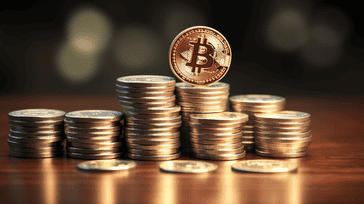The Role of Stablecoins in Crypto Currency Market Stability



The crypto currency market is a dynamic and often volatile space. As digital assets continue to gain mainstream acceptance, investors are increasingly looking for ways to reduce the inherent risk associated with these assets. Stablecoins, a class of crypto currencies that are pegged to a stable asset, such as the US dollar, have emerged as a reliable medium of exchange in the crypto currency market.
Stablecoins have the potential to provide stability to the crypto currency ecosystem, reducing the volatility that has plagued the market in the past. This section will explore the role of stablecoins in achieving market stability in the crypto currency space, highlighting the benefits they offer to investors and traders alike.
Crypto currency, also known as digital currency, uses encryption techniques to regulate the generation of units of currency and verify the transfer of funds. The emergence of bitcoin in 2009 signaled the birth of the crypto currency market, which has since grown exponentially.
Bitcoin is the most well-known and valuable crypto currency, but it is not the only one. There are now thousands of different crypto currencies available, each with their unique characteristics and use cases.
Underlying the technology of crypto currency is blockchain, a decentralized digital ledger that securely records transactions. This technology is also used in other sectors, ranging from supply chain management to healthcare.
"Bitcoin is a remarkable cryptographic achievement and the ability to create something that is not duplicable in the digital world has enormous value."
- Eric Schmidt, former CEO of Google
Bitcoin operates on a decentralized network of computers, each of which contributes to the verification of transactions and the generation of new units of currency. Transactions are recorded on the blockchain, which serves as a public ledger of all bitcoin transactions.
Unlike traditional currency, bitcoin is not backed by a physical commodity or government authority. Its value is determined by the demand for it in the market. Some investors view bitcoin as a hedge against inflation and a store of value, similar to gold.
Bitcoin paved the way for the development of other digital currencies, each with their unique properties. For example, Litecoin was designed to process transactions faster than bitcoin, while Ethereum allows for the creation of smart contracts on its blockchain network.
While bitcoin remains the most valuable crypto currency, it is important to consider other digital currencies and their potential uses in a diverse investment portfolio.

Crypto currency trading is the act of buying and selling digital assets through cryptocurrency exchanges. These exchanges act as marketplaces where buyers and sellers can trade various cryptocurrencies, including Bitcoin, Ethereum, Litecoin, and many others.
Cryptocurrency trading is similar to traditional stock trading, but with unique characteristics that make it a distinct industry. Crypto trading is open 24/7, allowing for round-the-clock trading activities. Additionally, most cryptocurrency exchanges operate on a decentralized system that eliminates the need for intermediaries such as banks.
Cryptocurrency exchanges act as intermediaries between buyers and sellers of digital assets, providing a platform for users to buy, sell, and exchange various cryptocurrencies. These exchanges can be centralized or decentralized, with centralized exchanges being the most common.
Centralized exchanges operate on a traditional order book model, with buyers and sellers creating orders that are matched according to the exchange's rules and regulations. Decentralized exchanges, on the other hand, operate on a peer-to-peer network where users interact directly with each other.
Cryptocurrency trading can be divided into two primary types: spot trading and derivatives trading. Spot trading involves the buying and selling of cryptocurrencies for immediate settlement, while derivatives trading involves the trading of financial instruments that derive their value from underlying assets such as cryptocurrencies.
Spot trading is the most common form of cryptocurrency trading and is popular among beginners. It involves the straightforward buying and selling of digital assets, with traders aiming to profit from price movements in the short term.
Derivatives trading, on the other hand, is considered more complex and risky than spot trading. It involves trading financial instruments such as futures, options, and swaps, with traders aiming to profit from the price movements of underlying assets.
Choosing the right cryptocurrency exchange is crucial for successful trading. Factors to consider when selecting an exchange include security, fees, liquidity, and ease of use. It is essential to consider the reputation of an exchange and its regulatory compliance before making a decision.
Popular cryptocurrency exchanges include Binance, Coinbase, Kraken, and Bitstamp, among others. These exchanges offer a range of trading pairs, including fiat-crypto and crypto-crypto pairs, providing users with access to a variety of digital assets.
Decentralized finance, also known as DeFi, is one of the most exciting and rapidly evolving areas of the crypto currency market. DeFi refers to a variety of financial applications and platforms built on blockchain technology that operate without intermediaries like banks.
DeFi platforms offer users a range of financial services, including lending and borrowing, trading, and asset management, among others. These services are typically accessible through decentralized applications (dApps) that run on blockchain networks like Ethereum.
The most significant advantage of DeFi is that it enables individuals to have complete control over their financial transactions and assets without relying on traditional financial institutions. This gives users the freedom to conduct transactions quickly and efficiently, without facing the limitations and bureaucracy of central authorities.
Moreover, DeFi provides users with greater transparency and security. Since DeFi transactions are recorded on blockchain networks, they are immutable and transparent, reducing the risk of fraud and manipulation.
However, DeFi is not without its challenges. The DeFi market is still in its early stages and is highly experimental, which means that it is subject to volatility and uncertainty. Additionally, there are concerns around the security and scalability of DeFi platforms, as well as the regulatory challenges they may face in the future.
Despite these challenges, DeFi is poised to transform the traditional financial sector and revolutionize the way we conduct financial transactions. As blockchain technology continues to mature, we can expect to see even greater innovation and adoption in the world of decentralized finance.

Crypto currency has come a long way since bitcoin's introduction in 2009. Over the years, it has spawned a plethora of alternative cryptocurrencies, also known as altcoins.
An altcoin is any cryptocurrency that is not bitcoin. Altcoins are designed to improve upon bitcoin's shortcomings, such as slow transaction times or high transaction fees. They also offer investors an opportunity to diversify their crypto currency portfolios and potentially generate higher returns.
Some of the most popular altcoins in the market include:
| Altcoin | Market Capitalization (as of August 2021) |
|---|---|
| Ethereum (ETH) | $324 billion |
| Binance Coin (BNB) | $77 billion |
| Cardano (ADA) | $70 billion |
| Polkadot (DOT) | $36 billion |
As you can see from the market capitalizations, altcoins have gained significant traction in the crypto currency market. They offer investors a wide range of options for diversification, allowing for a more balanced and less risky investment strategy.
Diversification is a strategy used by investors to spread their investments across different assets or markets, reducing the overall risk of their portfolio. In the crypto currency market, diversification is crucial due to the high volatility and unpredictability of prices. By investing in a range of altcoins, investors can mitigate the risk of significant losses from any one asset.
As with any investment strategy, diversification has its limitations and drawbacks. Investors must conduct thorough research and analysis to identify the most promising altcoins and ensure their portfolio is balanced and aligned with their investment goals and risk tolerance.
Altcoins have become increasingly popular in the crypto currency market, offering investors an opportunity to diversify their portfolios and potentially generate higher returns. However, diversification should be approached with caution and careful analysis to ensure a balanced and aligned portfolio that is aligned with individual investment goals and risk tolerance.
As we've discussed, volatility is a natural characteristic of the crypto currency market. However, with the introduction of stablecoins, the market has gained a powerful tool to mitigate this volatility, promoting market stability and investor confidence.
Stablecoins are cryptocurrencies that are backed by a stable asset, like the US dollar or gold, providing a reliable medium of exchange and a hedge against market fluctuations. By maintaining a stable value, stablecoins offer a safe haven for investors during times of market turbulence.
| Benefits of Stablecoins | Drawbacks of Stablecoins |
|---|---|
|
|
Stablecoins provide a range of benefits beyond reducing volatility in the market, including transparency, decentralization, and fast transactions. However, there are also drawbacks to consider, such as the potential counterparty risk associated with centralized issuers and the regulatory uncertainty surrounding their use.
Despite these challenges, the use of stablecoins is on the rise within the crypto currency market. The total market capitalization of stablecoins has surged in recent years, signaling their growing importance in promoting market stability and investor confidence.
"Stablecoins offer a safe haven for investors during times of market turbulence."
As more investors seek to diversify their crypto currency portfolios and mitigate market risks, the demand for stablecoins is likely to continue to grow. By providing a stable value and promoting market stability, stablecoins offer a valuable tool for investors looking to navigate the dynamic and sometimes unpredictable world of crypto currency.

Investing in crypto currency can offer exciting opportunities for growth and diversification in your portfolio. However, it's important to understand the inherent risks involved before diving in.
One of the main advantages of investing in crypto currency is its potential for high returns. With some cryptocurrencies experiencing dramatic price increases, investors who got in early have seen significant gains. However, it's important to note that this level of growth is not guaranteed and can be accompanied by significant volatility.
Another benefit of crypto currency investment is its potential for diversification. By adding crypto assets to your portfolio, you can reduce your reliance on traditional investments like stocks and bonds, which may be subject to the same market forces.
However, investing in crypto also comes with significant risks. The crypto currency market is highly volatile, subject to sudden price swings caused by various factors such as regulatory changes or technological advancements.
Additionally, the lack of regulation in the crypto market means that investors may be at risk of fraud or scams. It's crucial to thoroughly research any crypto asset before investing and to only use reputable exchanges.
Ultimately, investing in crypto currency can offer lucrative opportunities for growth and diversification in a portfolio. However, it's important to carefully consider the risks involved and to approach investment in this volatile market with caution.
Crypto mining plays a vital role in maintaining the integrity and security of blockchain networks. By using powerful computers to solve complex mathematical problems, miners are able to validate transactions and add new blocks to the blockchain, ensuring the accuracy and immutability of the ledger.
During the mining process, new units of crypto currency are also minted, providing an incentive for miners to contribute their computing power to the network. This creates a decentralized system, where there is no central authority controlling the issuance or distribution of crypto currency.
However, crypto mining is not without its challenges. As the computing power required to mine crypto currency has increased, so too has the energy consumption associated with the process. This has led to concerns about the environmental impact of mining, as well as the potential for centralization of mining power among a few large players.
Despite these challenges, crypto mining remains a crucial aspect of the crypto currency ecosystem. As the demand for digital assets continues to grow, the need for secure and efficient mining operations will only increase. As such, the development of new mining technologies and more sustainable energy sources will be critical to ensuring the long-term viability of the crypto currency market.
The crypto currency market has experienced rapid growth and significant changes since the emergence of bitcoin in 2009. As the market continues to mature, several future trends are anticipated that could shape the market's trajectory.
One trend that is expected to gain momentum is the increased adoption of crypto currency by institutional investors and businesses. The past few years have seen a growing interest in crypto assets by institutional players such as hedge funds, asset managers, and corporations. This trend is likely to continue as more companies see the potential benefits of investing in crypto currency.
Another potential trend in the crypto currency market is the emergence of central bank digital currencies (CBDCs). Several central banks worldwide, including the People's Bank of China and the European Central Bank, are exploring the possibility of creating CBDCs. If implemented, CBDCs could provide a hybrid form of currency that combines the benefits of traditional fiat currency with the advantages of crypto currency.
The crypto currency market has been plagued by regulatory uncertainty, which has hindered its development and adoption. However, recent years have seen some progress in regulatory clarity, with countries such as Japan and Switzerland creating crypto-friendly regulatory frameworks. The trend towards greater regulatory clarity is likely to continue as governments and regulatory bodies seek to strike a balance between protecting investors and fostering innovation.
Decentralized finance (DeFi) has emerged as a popular use case for crypto currency, providing users with access to a variety of financial services without relying on traditional intermediaries. DeFi protocols are built on blockchain technology and offer services such as lending, borrowing, and trading. As the DeFi ecosystem continues to develop, it is expected to attract greater numbers of users and capital.
Blockchain technology is the backbone of the crypto currency market, providing a secure and transparent way to record transactions. As the market continues to mature, the development of blockchain technology is expected to accelerate, bringing with it innovations such as greater scalability, interoperability, and privacy. These developments will help make crypto currency more accessible and user-friendly, increasing its adoption and mainstream appeal.
Finally, a trend that is gaining traction in the crypto currency market is the rise of digital collectibles. Digital collectibles are unique, verifiable, and scarce assets built using blockchain technology. They can take the form of anything from artwork to virtual real estate, and their value is determined by supply and demand. As the market for digital collectibles matures, it is expected to provide a new use case for crypto currency, attracting new users and capital.
In conclusion, stablecoins play a critical role in achieving market stability in the ever-changing world of crypto currency. As digital assets become increasingly prevalent, stablecoins provide a reliable medium of exchange and reduce volatility in the market, particularly during times of turbulence.
While the crypto currency market is known for its unpredictability, investing in stablecoins can provide a sense of security and a safe haven for investors. Diversifying your portfolio with stablecoins can help mitigate the risks associated with the volatility of other crypto assets.
It is important to remember that investing in crypto currency carries inherent risks, and thorough research and due diligence is necessary before making any investment decisions. However, with proper caution, the potential opportunities presented by the crypto currency market are numerous.
The future of the crypto currency market holds promise, with advancements in technology and regulatory frameworks contributing to its growth and development. As the market evolves, so too will the role of stablecoins and their importance in achieving market stability.
Overall, stablecoins are a valuable tool in the world of crypto currency, providing a reliable and stable foundation for investors and contributing to market stability. As the market continues to mature, it is likely that we will see an even greater demand for stablecoins and their role in mitigating volatility.
Stablecoins are a type of cryptocurrency that are designed to maintain a stable value by being pegged to a specific asset, such as a fiat currency or a commodity. They provide a reliable medium of exchange in the volatile world of crypto currency.
Stablecoins are designed to have a fixed value, which helps to reduce the price fluctuations commonly associated with other cryptocurrencies. This stability makes them a popular choice for traders and investors who want to mitigate risk.
Stablecoins play a crucial role in achieving market stability by providing a stable unit of account and medium of exchange. Their value can be easily understood and trusted, making them a valuable tool for everyday transactions within the crypto currency market.
When the crypto currency market experiences volatility and uncertainty, stablecoins can act as a safe haven for investors. Their stability ensures that the value of investments remains relatively steady, even when other cryptocurrencies may be experiencing significant price fluctuations.
Yes, stablecoins are widely accepted for transactions in the crypto currency market. They provide a reliable medium of exchange and can be used for various purposes, such as buying goods and services, transferring funds, or trading on cryptocurrency exchanges.
Yes, stablecoins are increasingly being used for cross-border transactions due to their speed and efficiency. They enable individuals and businesses to transfer funds across borders quickly and securely without the need for traditional banking intermediaries.
Stablecoins can be bought or traded on various cryptocurrency exchanges. These exchanges provide platforms where individuals can buy, sell, or trade stablecoins with other cryptocurrencies or fiat currencies, depending on the specific exchange.
The regulation of stablecoins varies depending on the jurisdiction. Some stablecoins may fall under the purview of existing financial regulations, while others may operate in a more decentralized manner. It is important to understand the regulatory landscape of stablecoins in your specific region.
Using stablecoins for everyday transactions offers several benefits, including reduced transaction costs, faster settlement times, and increased privacy. Additionally, stablecoins can provide individuals and businesses with access to financial services in regions where traditional banking infrastructure is limited.
While stablecoins are primarily designed as a means of exchange, they can also be used as an investment. Some stablecoins offer incentives for holding them, such as earning interest or participating in governance decisions. However, it is important to carefully evaluate the risks and potential returns before investing in stablecoins.